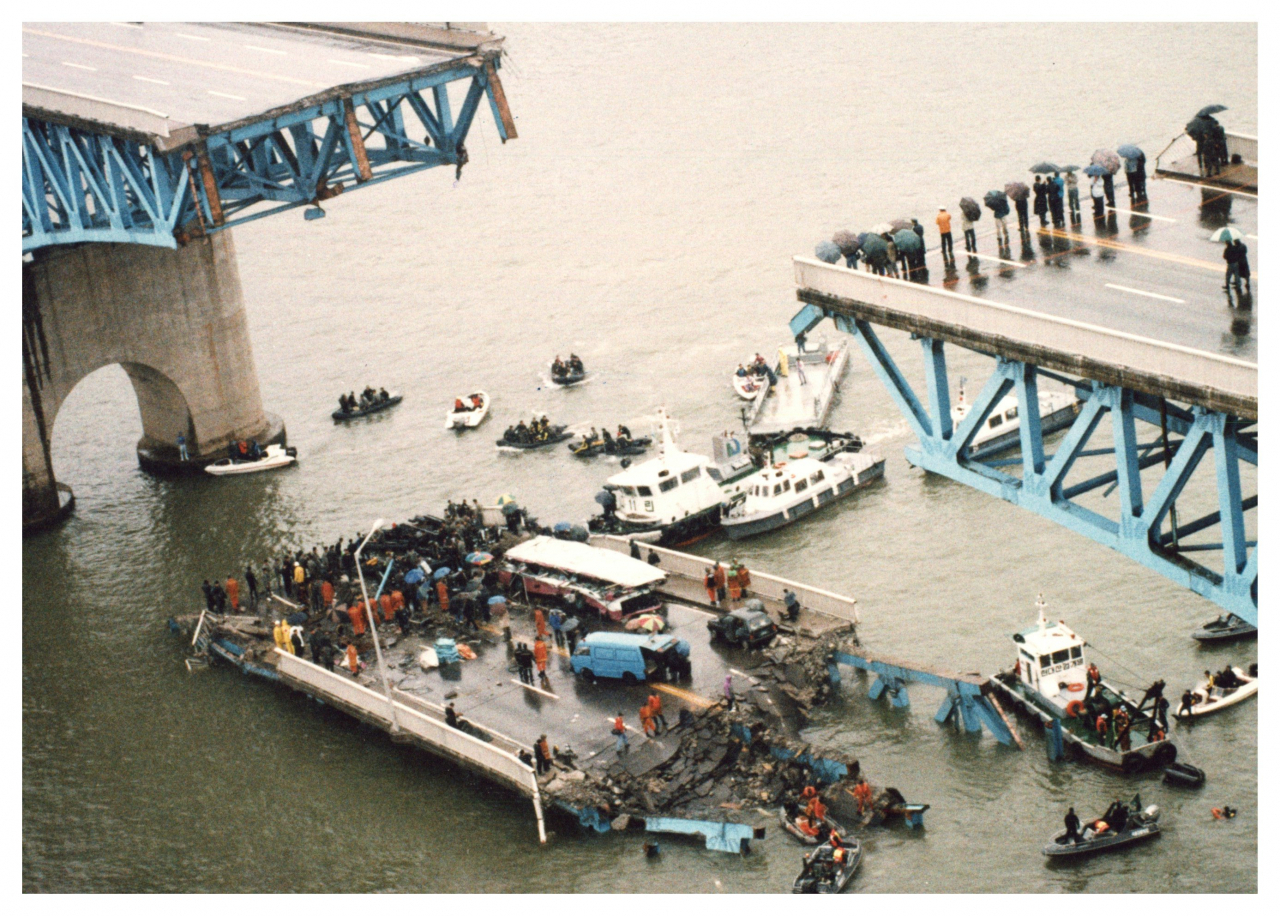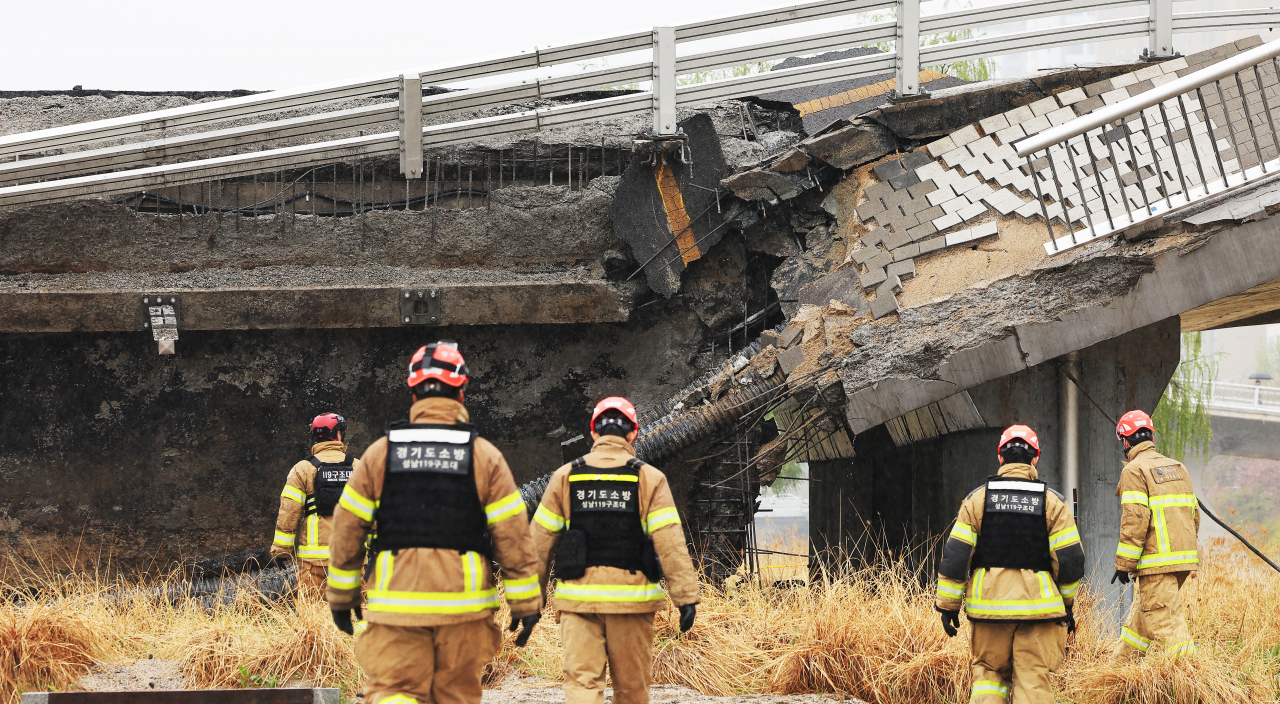[Korea History] Bridge collapse lays bare dark side of 'Han River miracle’
Fatal 1994 Seongsu Bridge collapse brought to light lax regulations and lack of safety awareness
By Yoon Min-sikPublished : July 26, 2023 - 15:25

It was a regular Friday morning on Oct. 21, 1994. The 1.2-kilometer Seongnsu Bridge over the Han River in Seoul was bustling with commuting cars as usual, amid light rain.
At around 7:38 a.m., a 48-meter-long section of the bridge suddenly cracked and fell onto the river, bringing down several cars with it. A passenger bus came to a screeching halt but failed to escape its fate, as it too plunged to the water below. So did a few other cars.
"Minutes after I entered the Seongsu Bridge as usual to go to my office in southern Seoul, the bridge suddenly collapsed, sending vehicles falling into the water," an eye witness named Yu Hae-pil was quoted in The Korea Herald’s article, “Bridge collapses, killing 32,” published as the top story of the Oct. 22, 1994 edition.
The majority of the victims were passengers of the ill-fated bus – No. 16 -- which precariously hung on the edge for a moment before falling on top of the detached slab of the bridge floating on the river.
Twenty-nine of the 32 on the bus died, including eight from Muhak Girls’ High School and one from Muhak Middle School.
Dark side of 'miraculous' growth
In the early 90s, it seemed almost like anything was achievable for this hard-working nation. Economic growth and urbanization were continuing at an astonishing rate, the country had seen mass protests lead to democratic constitutional reforms and direct presidential elections, and local brands were gaining a stronger foothold in overseas markets.
Behind such rapid progress, however, were some unwanted -- and deadly -- ramifications.
In 1992, two years before the Seongsu Bridge gave way, another bridge under construction had collapsed, which should have served as a warning about the dangers of shoddy construction practices.
The Seongsu Bridge tragedy was arguably the most shocking structural failure up until that point, but it would be overshadowed by yet another tragedy the next year: when the Sampoong Department Store in Seoul collapsed and killed over 500 people.
This string of fatal mass accidents earned the Kim Young-sam administration the unflattering nickname, the "era of calamities," highlighting the consequences of cutting corners and sacrificing safety issues in the pursuit of rapid success.
“We (Korea) have achieved great accomplishment in the past 30 years of economic growth. But in the process, we cannot deny that we’ve pursued quantity over quality, and demonstration (to the world) over practicality,” then-President Kim said in a public statement following the Seongsu Bridge collapse.
“This incident happened because we’ve failed to achieve internal stability ... The government gravely takes responsibility, in a perspective that this incident did not naturally occur, but was made to happen," he continued.
The Seongsu Bridge was completed in October 1979, almost exactly 15 years before the tragedy. A white paper commissioned by law enforcement authorities concludes that the collapse was jointly the product of faulty construction by the now-defunct Donga Construction and inadequate maintenance on the Seoul Metropolitan Government’s part. It was found that the city had failed to carry out basic inspections and regular repairs of the bridge.
Although the bridge was designed to withstand the weight of 80,000 cars a day, over 160,000 vehicles were using the bridge every day by October 1994 -- due to a boost in traffic in the area due to the completion of the Seongsu-Sanggye section of the Dongbu Expressway the previous year.
The maximum weight of each of the vehicles allowed on the bridge -- according to its original design -- was 18 tons, which was the weight of a conventional freight truck at the time. But the bridge’s northern part was close to a cement plant, from which transit mixers weighing as much as 25 tons emerged every day and crossed the bridge without being regulated.
After the tragedy, investigators conducted a simulation using the same faulty welding as the bridge had and found that the structure might have collapsed in 12 years had the number and weight of the vehicles on the bridge stayed under what it had been designed to withstand. They then did a second simulation of the bridge based on the actual weight of the vehicles that it had to withstand in real life, and concluded that the bridge should have collapsed after 8.5 years.
In short, it was a miracle that the bridge even lasted for a decade and a half, between the faulty and rushed construction by the cheapest bidder and the city government's utter lack of effort to regulate traffic and maintain the bridge properly.
Just hours before the collapse, some drivers on the Seongsu Bridge noticed a loose 1.3-meter-by-2-meter metal plate on the structure, which was meant to cover a gap in the deck. One driver even reported to the city having experienced an abnormal impact when their car passed over the bridge at around 6 a.m., an hour and a half before the collapse. No emergency measures had been taken in response to these reports.
The collapse sparked an overhaul in the Seoul city government leadership. Seoul Mayor Lee Won-jong was dismissed and his successor, Woo Myun-gyu, resigned from the post just 11 days into his new job, after it was found that he was the man who had given the go-ahead to the bridge’s construction originally. The post of Seoul mayor was at that time still appointed by the central government, not directly elected as today.
The construction company and the city government officials responsible for overseeing the bridge were held responsible and punished. But while it was widely suspected that large-scale corruption and bribery had been involved in the construction company getting away with such substandard procedures, charges were not pressed in the legal proceedings following the incident.
This was in stark contrast to the sinking of the Sewol Ferry two decades later in 2014, which left 304 people dead or missing, after which a comprehensive government investigation was conducted and found corruption related to lax safety inspections.

Safety checks nationwide
The Seongsu Bridge collapse sent shockwaves across the country and fueled skepticism about structures built under similarly lax safety regulations and inspections. The government conducted a nationwide safety inspection on all buildings and Han River bridges, and found that only 2 percent of the buildings were safe, with the Dangsan Railway Bridge -- on which Seoul Metro’s Line No. 2 runs -- in western Seoul facing severe structural issues.
The government decided to demolish and reconstruct the Dangsan Bridge but only in December 1995, a full year after the inspection and after the tragic aforementioned Sampoong Department Store collapse. The bridge in fact collapsed on its own during the demolition process.
The other Han River bridges -- the Gwangjin Bridge, Hannam Bridge, Mapo Bridge and Yanghwa Bridge -- underwent repairs.
The biggest apparent change was to the country's maintenance system for infrastructure. In 1995, South Korea implemented the Special Act on Safety Control for Infrastructure that mandated any structure 10 years or older to go through regular inspection by non-government experts. The Korea Authority of Land & Infrastructure Safety was launched to oversee the process.
The act states that structures are to be sorted into three classes depending on their size, with the Han River bridges being a “first-class public structure," which is subject to a top-level “diagnosis of safety” procedure once every four to six years -- depending on what grade it gets. The number of the bridges running across the huge river has jumped from 19 in 1994 to 31 as of now.
Despite the overhaul, recent incidents indicate that there are still loopholes in the safety measures that must be addressed to prevent disasters.
The April 2023 collapse of the Jeongja Bridge -- a second-class public structure -- which killed one person and injured another -- has sparked calls for stricter safety measures for smaller structures as well. Nearly three decades after the Seongsu Bridge tragedy, this smaller bridge over the Tan Stream in Seongnam, Gyeonggi Province also collapsed due to the lack of proper maintenance and safety inspections.
Second-class public structures are not subject to diagnoses of safety, but only regular safety inspections that check mainly the exterior without thorough examination. It was revealed in the state investigation that the 30-year-old bridge had not been properly repaired.
Following the accident, the government decided earlier this month that public structures of all classes would be subject to diagnoses of safety once 30 years have passed since they were built.




















![[Today’s K-pop] Treasure to publish magazine for debut anniversary](http://res.heraldm.com/phpwas/restmb_idxmake.php?idx=642&simg=/content/image/2024/07/26/20240726050551_0.jpg&u=)